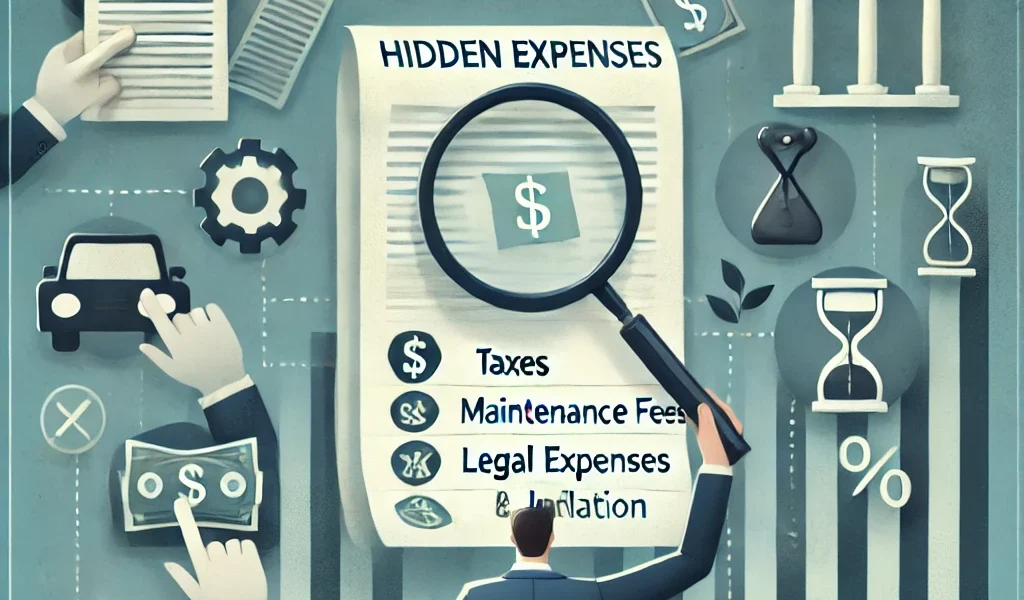When planning your investment budget, most people focus on obvious costs such as purchasing assets, transaction fees, and maintenance costs. However, hidden expenses can quietly eat into your returns and destabilize your financial plans. Ignoring these costs can lead to significant financial setbacks, making it crucial to identify and manage these hidden expenses effectively.
In this blog, we will explore common hidden costs that can derail your investment budget, provide actionable tips to mitigate their impact, and offer budgeting strategies to help you stay on track.
1. Tax Implications
One of the most underestimated costs of investing is taxes. Depending on the type of investment, you may encounter capital gains tax, dividend tax, or property tax. Not accounting for these can significantly reduce your net returns.
Key Considerations:
- Capital Gains Tax: Applies when you sell an investment for a profit. The rate varies depending on the duration you hold the investment (short-term vs. long-term gains).
- Dividend Tax: Certain dividends are taxable, which can affect your passive income.
- Property Tax: If you invest in real estate, property taxes are an ongoing obligation that varies by location.
Tip: Consult a tax advisor to understand your obligations and consider tax-efficient investment vehicles such as retirement accounts (e.g., 401(k), IRA) to minimize your tax liability.
2. Inflation Erosion
Inflation reduces the purchasing power of your money over time. If your investment returns do not outpace inflation, your real gains diminish.
Key Considerations:
- Over time, inflation increases the cost of living and can erode fixed-income investments.
- Historical inflation rates average around 2-3% annually, but this can vary based on economic conditions.
Tip: Diversify your portfolio with assets that historically outperform inflation, such as equities, real estate, and inflation-protected securities (e.g., TIPS).
3. Management Fees and Commissions
Investment-related fees can seem small but add up over time, impacting long-term wealth accumulation.
Key Considerations:
- Expense Ratios: Mutual funds and ETFs charge annual fees, which reduce your overall returns.
- Advisory Fees: Financial advisors may charge a percentage of assets under management (AUM) or flat fees.
- Transaction Costs: Each trade incurs a fee, particularly in actively managed accounts.
Tip: Choose low-cost index funds or commission-free platforms to reduce these expenses. Always review the fee structure before investing.
4. Opportunity Costs
Opportunity cost refers to the potential gains you forgo by choosing one investment over another.
Key Considerations:
- Investing in low-yield assets may prevent you from capitalizing on higher-return opportunities.
- Holding excessive cash can lead to missed market growth.
Tip: Regularly assess your portfolio to balance risk and reward, and ensure your asset allocation aligns with your financial goals.
5. Currency Fluctuations
For international investments, currency risk can erode returns when exchange rates fluctuate.
Key Considerations:
- Foreign investments expose you to exchange rate volatility.
- Currency devaluation in the investment country can reduce your returns.
Tip: Consider hedging currency risks using currency-hedged funds or diversification across multiple regions.
6. Legal and Compliance Costs
Investing often comes with regulatory and legal obligations that can incur costs if not managed properly.
Key Considerations:
- Property Investments: Legal fees for purchase agreements, title checks, and tenant issues.
- Business Investments: Compliance costs for licensing, regulatory filings, and audits.
Tip: Work with experienced legal professionals to ensure compliance and account for legal costs when budgeting.
7. Maintenance and Upkeep Costs
Physical assets such as real estate and equipment require ongoing maintenance.
Key Considerations:
- Real estate involves repair costs, property management, and renovations.
- Equipment investments need routine servicing and replacement parts.
Tip: Set aside a maintenance fund to cover unexpected repairs and preserve asset value.
8. Insurance Costs
Insuring your investments protects against financial loss but adds a recurring expense.
Key Considerations:
- Property Insurance: Essential for real estate to protect against damage and liability.
- Portfolio Insurance: Options like put options protect against downside risk.
Tip: Evaluate insurance needs based on asset type and risk exposure while balancing costs and coverage.
9. Liquidity Constraints
Certain investments may lock up your funds, limiting your ability to access cash when needed.
Key Considerations:
- Real estate and private equity often have long holding periods.
- Penalties may apply for early withdrawal from retirement accounts.
Tip: Maintain a liquid emergency fund and balance illiquid investments with easily accessible assets.
10. Hidden Operational Costs in Business Investments
Investing in a business involves hidden operational costs that can cut into profits.
Key Considerations:
- Unexpected technology upgrades, employee benefits, and regulatory compliance.
- Marketing and customer acquisition costs may exceed projections.
Tip: Conduct thorough due diligence and establish contingency reserves to cover unforeseen business expenses.
How to Manage and Reduce Hidden Expenses
- Conduct Regular Expense Audits: Review all investment-related costs periodically to identify and control hidden expenses.
- Work with Professionals: Tax advisors, financial planners, and legal experts can help uncover and mitigate hidden costs.
- Diversify Your Portfolio: Reduce the impact of specific hidden costs by spreading investments across different asset classes.
- Use Tax-Advantaged Accounts: Maximize tax-deferred or tax-free growth through retirement and other tax-efficient accounts.
- Maintain an Emergency Fund: Ensure liquidity to cover unforeseen costs without disrupting your investment strategy.
Final Thoughts
Hidden expenses can quietly undermine your investment strategy if left unchecked. By identifying these costs upfront and implementing proactive budgeting strategies, you can protect your investment budget and achieve long-term financial success. Regularly reviewing your portfolio and working with qualified professionals will help you stay ahead of unexpected expenses and maximize your returns over time.
By understanding and addressing these hidden expenses, you can maintain a robust investment budget that supports your financial goals while avoiding costly surprises along the way.



